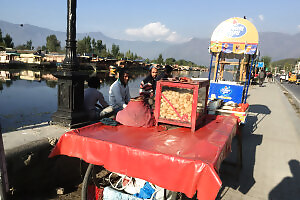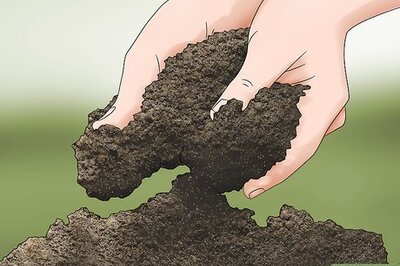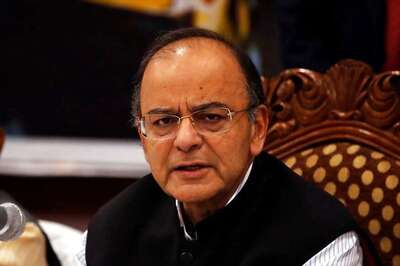
views
Srinagar: Sitting on the porch of a houseboat against the finely-hewed walnutwood expanse, Moomin Ahmad spends his days lonesome. A pervasive silence has engulfed the Dal Lake in Srinagar.
The operators of shikaras (arched boats) are fast asleep on the boats’ cosy seats, hopeless of finding a customer they can take for a ride in the floating market, past the shade of chinar trees. The only activity in the calm waters of the lake is that of anglers, who are sitting on the decks of decades-old but well-furnished houseboats—waiting slothfully to catch fish.
Over two months have passed since the last batch of tourists left hastily from the Ahmad’s 36-year old houseboat, Montana.
Kashmir was in panic as it entered the first week of August. The government, after calling around 40,000 additional troops to the Valley, issued an advisory for all the tourists, asking them to leave immediately. This was something that happened for the first time in the turbulent history of Kashmir.
On August 5, everything appeared desolate. Except for a huge number of forces fanning across the Valley—roads blocked with barricades and coils of concertina wires—human life had disappeared. The usually abuzz Dal Lake, the tourist hub of Kashmir, had turned ghostly. Since then no one has visited Montana and the dozen other houseboats spread in columns facing the banks of the lake.
Ahmad, who is the fourth generation in his family working in the tourism sector, has covered the furniture and artworks with bed sheets to protect them from the dust.
“We have started working on renovation and repairs,” Ahmad told News18. “Otherwise, it would be hard for us to find days for this work even in the off-season.”
Over two months have passed since the central government stripped Jammu and Kashmir of its special status under Article 370 and divided the state into two Union Territories. Expecting resistance from the local populace, the government had called in additional troops, jailed the separatist and mainstream politicians (including the former chief ministers), directed tourists to leave the Valley and imposed the crippling clampdown with internet and phone services snapped.
On Thursday, after over 60 days, the government withdrew the tourist advisory. However, in the Dal Lake, the shikara-walahs and the people who earn their bread through tourism—which contributes 6 per cent of the GDP of Jammu and Kashmir—have little hope.

“The damage that has been done can’t be reversed immediately,” said a top official in the State Tourism Department, wishing not be identified. “It's not that there was a shutter which we had closed and once we open it people will be there waiting to come in. We have to create the atmosphere and win the trust of people that it is safe to travel to Kashmir.”
Kashmir's hospitality sector, according to different reports and estimates, is a Rs 5,000-crore industry. The losses in the tourism sector, as per different local business bodies, is over Rs 1, 500 crore.
Like Ahmad’s Montana, 900 houseboats, 1,300 hotels and 650 shikara are empty, waiting for tourists.
After the advisory was issued, some tourists couldn’t fathom the level of urgency that Kashmir was going to witness. Some stayed despite police making regular inspection in hotels and houseboats.
“Four days after the advisory was issued, there were over 1,500 tourists in the Valley, reluctant to leave,” a senior official at the Tourist Police wing of Jammu and Kashmir police told News18.
In the Gangbal area alone, which is a trekking route in Ganderbal district of central Kashmir, the official revealed there were around 137 foreign nationals hiking in the area at the time. On August 27, a gun battle started in the area, which went on for a few days and two militants were killed after army airdropped para-troopers. Even when around 15 days passed, there were tourists in the area who didn’t leave.
The Kashmir police was on tenterhooks, as per officials, after the Israeli embassy in New Delhi said one of their nationals was in Kashmir. The authorities couldn’t contact the Israeli lady for around a month.
“She was travelling around the Valley with a local guide from August 25 till September 25, and we were unable to trace her,” said an official from the tourist police.
But these are just instances that worry the authorities. The scenario of tourism sector can be better understood by the figures provided by the government.
As per the data provided by state tourism department, 3,17,284 tourists visited Kashmir in the months of June and July. Post the advisory, in August and September, only 14,692 tourists were left. There was a dip of around 96 per cent.
There are also some other sectors which are directly or indirectly linked with the tourism sector such as transport, handicrafts and Kashmiri arts and crafts.
Pardeep Kumar, who hails from Bihar’s Mongar area, has been running a snack stall on the Boulevard road from the last 24 years. Thousands of non-locals like Kumar, who earned their livelihood in Kashmir, fled after the government advisory.

Kumar, however, was among those few who stayed. But the decision has come at a big price. “I used to earn Rs 100 to Rs 1,500 a day. But for around a month (after August 5) I had no work,” he said. These days Kumar makes a hundred rupees a day.
“My business is dependent on the tourists. In this situation, it is hard to manage even two meals in a day,” he rues.
The officials in the state tourism department, houseboat owners and people working in the tourism sector feel that it will take a lot of time to get their business restored to normal.
The state tourism department is going to promote Kashmir by organising road shows and putting up advertisements, but the question everyone is asking is: Will that work?
Not many are hopeful given the turbulent and shaky situation of Kashmir.
“Anytime, anything can happen in Kashmir. The tourism may again flourish after a few months but a single unpleasant incident will ruin everything,” says Ahamd, reclining on the porch. Unlike his grandfather and father, who worked in the tempestuous situation of Kashmir and were able to establish their own travel agency, Ahmad sees no future in the traditional business.
“I will leave the Valley in some time. The situation here is unpredictable,” says Ahmad, with a firm plan to study abroad and find a good job.
Every year, his boat Montana used to be jostled in December with tourists from South Africa. “They were our regular customers. We had built very friendly relations,” says Ahmad, adding that a few days ago, he called them from a landline phone advising them not to visit Kashmir this winter.
The authorities on Saturday announced that all postpaid mobile phones will be restored and internet will be resumed at tourist destinations. The move is aimed at resuming normalcy and attracting tourists.
“Tourists won’t get attracted to a place where things get upended in minutes,” says Ahmad, leaving us with one question: Will tourists return to the Vale of Kashmir?


















Comments
0 comment